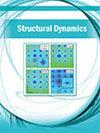Time resolved transient circular dichroism spectroscopy using synchrotron natural polarization
IF 2.3
2区 物理与天体物理
Q3 CHEMISTRY, PHYSICAL
引用次数: 15
Abstract
Ultraviolet (UV) synchrotron radiation circular dichroism (SRCD) spectroscopy has made an important contribution to the determination and understanding of the structure of bio-molecules. In this paper, we report an innovative approach that we term time-resolved SRCD (tr-SRCD), which overcomes the limitations of current broadband UV SRCD setups. This technique allows accessing ultrafast time scales (down to nanoseconds), previously measurable only by other methods, such as infrared (IR), nuclear magnetic resonance (NMR), fluorescence and absorbance spectroscopies, and small angle X-ray scattering (SAXS). The tr-SRCD setup takes advantage of the natural polarization of the synchrotron radiation emitted by a bending magnet to record broadband UV CD faster than any current SRCD setup, improving the acquisition speed from 10 mHz to 130 Hz and the accessible temporal resolution by several orders of magnitude. We illustrate the new approach by following the isomer concentration changes of an azopeptide after a photoisomerization. This breakthrough in SRCD spectroscopy opens up a wide range of potential applications to the detailed characterization of biological processes, such as protein folding and protein-ligand binding.同步加速器自然偏振的时间分辨瞬态圆二色光谱
紫外(UV)同步辐射圆二色性(SRCD)光谱对生物分子结构的测定和理解做出了重要贡献。在本文中,我们报告了一种创新的方法,我们称之为时间分辨SRCD(tr SRCD),它克服了当前宽带UV SRCD设置的局限性。这项技术允许访问超快的时间尺度(低至纳秒),以前只能通过其他方法测量,如红外(IR)、核磁共振(NMR)、荧光和吸收光谱以及小角度X射线散射(SAXS)。tr SRCD装置利用弯曲磁体发射的同步辐射的自然偏振,以比任何当前SRCD装置更快的速度记录宽带UV CD,将采集速度从10mHz提高到130 Hz和几个数量级的可访问时间分辨率。我们通过跟踪偶氮肽在光异构化后的异构体浓度变化来说明新方法。SRCD光谱的这一突破为生物过程的详细表征开辟了广泛的潜在应用,如蛋白质折叠和蛋白质配体结合。
本文章由计算机程序翻译,如有差异,请以英文原文为准。
求助全文
约1分钟内获得全文
求助全文
来源期刊

Structural Dynamics-Us
CHEMISTRY, PHYSICALPHYSICS, ATOMIC, MOLECU-PHYSICS, ATOMIC, MOLECULAR & CHEMICAL
CiteScore
5.50
自引率
3.60%
发文量
24
审稿时长
16 weeks
期刊介绍:
Structural Dynamics focuses on the recent developments in experimental and theoretical methods and techniques that allow a visualization of the electronic and geometric structural changes in real time of chemical, biological, and condensed-matter systems. The community of scientists and engineers working on structural dynamics in such diverse systems often use similar instrumentation and methods.
The journal welcomes articles dealing with fundamental problems of electronic and structural dynamics that are tackled by new methods, such as:
Time-resolved X-ray and electron diffraction and scattering,
Coherent diffractive imaging,
Time-resolved X-ray spectroscopies (absorption, emission, resonant inelastic scattering, etc.),
Time-resolved electron energy loss spectroscopy (EELS) and electron microscopy,
Time-resolved photoelectron spectroscopies (UPS, XPS, ARPES, etc.),
Multidimensional spectroscopies in the infrared, the visible and the ultraviolet,
Nonlinear spectroscopies in the VUV, the soft and the hard X-ray domains,
Theory and computational methods and algorithms for the analysis and description of structuraldynamics and their associated experimental signals.
These new methods are enabled by new instrumentation, such as:
X-ray free electron lasers, which provide flux, coherence, and time resolution,
New sources of ultrashort electron pulses,
New sources of ultrashort vacuum ultraviolet (VUV) to hard X-ray pulses, such as high-harmonic generation (HHG) sources or plasma-based sources,
New sources of ultrashort infrared and terahertz (THz) radiation,
New detectors for X-rays and electrons,
New sample handling and delivery schemes,
New computational capabilities.
 求助内容:
求助内容: 应助结果提醒方式:
应助结果提醒方式:


